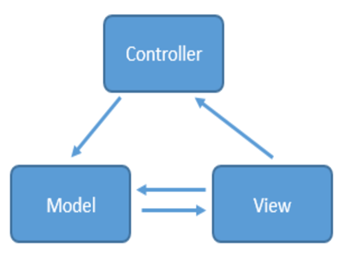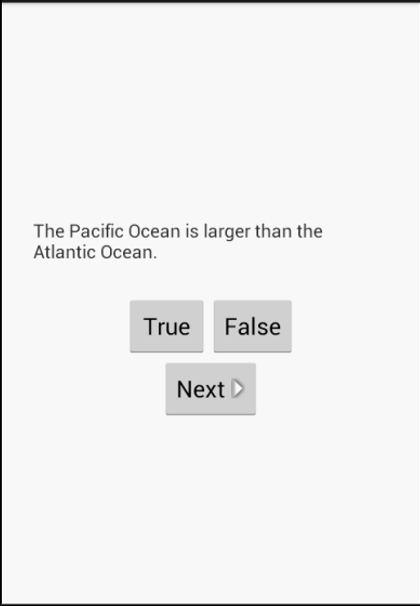样例GeoQuiz应用开发 第2章
先介绍一下MVC,Model View Controller,是软件架构中最常见的一种框架。
简单来说就是通过 controller 的控制去操作 model 层的数据,并且返回给 view 层展示,具体见下图

当用户出发事件的时候,view 层会发送指令到 controller 层,接着 controller 去通知model层更新数据,model层更新完数据以后直接显示在view层上,这就是MVC的工作原理。
1)模型(Model)
Model是一个应用系统的核心部分,代表了该系统实际要实现的所有功能处理。比如:在视频播放器中,模型代表一个视频数据库及播放视频的程序函数代码;在拍照应用中,模型代表一个照片数据库,及看图片时的程序函数代码。在一个电话应用中,Model代表一个电话号码簿,以及拨打电话和发送短信的程序函数代码。Model在values目录下通过xml文件格式生成,也可以通过硬编码的方式直接Java代码生成。
2)视图(View)
View是软件应用传送给用户的一个反馈结果。它代表软件应用中的图形展示、声音播放、触觉反馈等职责。视图的根节点是应用程序的自身窗口。比如,视频播放器中可能包含当前播放的画面,这个画面就是一个视图。另一个视图组件可能是该视频的文字标题。再一个就是一些播放按键,View在layout目录下通过xml文件格式生成,用findViewById()获取;也可以通过硬编码的方式直接Java代码生成。
3)控制器(Controller)
Controller在软件应用负责对外部事件的响应,包括:键盘敲击、屏幕触摸、电话呼入等。Controller实现了一个事件队列,每一个外部事件均在事件队列中被唯一标识。框架依次将事件从队列中移出并派发出去。
任务要求实现GeoQuiz 能从多个题目之间切换。(所有的代码都会更新)

代码更新:
activity_main.xml代码:
<LinearLayout xmlns:android="http://schemas.android.com/apk/res/android"
android:layout_width="match_parent"
android:layout_height="match_parent"
android:gravity="center"
android:orientation="vertical">
<TextView
android:id="@+id/question_text_view"
android:layout_width="wrap_content"
android:layout_height="wrap_content"
android:padding="24dp"
/>
<LinearLayout
android:layout_width="wrap_content"
android:layout_height="wrap_content"
android:orientation="horizontal">
<Button
android:id="@+id/true_button"
android:layout_width="wrap_content"
android:layout_height="wrap_content"
android:text="@string/true_button"/>
<Button
android:id="@+id/false_button"
android:layout_width="wrap_content"
android:layout_height="wrap_content"
android:text="@string/false_button"/>
</LinearLayout>
<Button
android:id="@+id/next_button"
android:layout_width="wrap_content"
android:layout_height="wrap_content"
android:text="@string/next_button"/>
</LinearLayout>
MainActivity.java代码 :
package com.example.a83856.myapplication1;
import android.support.v7.app.AppCompatActivity;
import android.os.Bundle;
import android.view.View;
import android.widget.Button;
import android.widget.ImageButton;
import android.widget.TextView;
import android.widget.Toast;
public class MainActivity extends AppCompatActivity {
private Button mTrueButton;
private Button mFalseButton;
private Button mNextButton;
private TextView mQuestionTextView;
private Question[] mQuestionBank=new Question[]{
new Question(R.string.question_ocean,true),
new Question(R.string.question_mideast,false),
new Question(R.string.question_africa,false),
new Question(R.string.question_americas,true),
new Question(R.string.question_asia,true),
};
private int mCurrentIndex=0;
private void updateQuestion(){
int question=mQuestionBank[mCurrentIndex].getTextResId();
mQuestionTextView.setText(question);
}
private void checkAnswer(boolean uesrPressesTrue){
boolean answerIsTrue=mQuestionBank[mCurrentIndex].isAnswerTrue();
int messageResId=0;
if(uesrPressesTrue==answerIsTrue)
messageResId=R.string.correct_toast;
else
messageResId=R.string.incorrect_toast;
Toast.makeText(this,messageResId,Toast.LENGTH_SHORT).show();
}
@Override
protected void onCreate(Bundle savedInstanceState) {
super.onCreate(savedInstanceState);
setContentView(R.layout.activity_main);
mQuestionTextView=(TextView)findViewById(R.id.question_text_view);
updateQuestion();
mTrueButton=(Button)findViewById(R.id.true_button);
mTrueButton.setOnClickListener(new View.OnClickListener() {
@Override
public void onClick(View v) {
checkAnswer(true);
}
});
mFalseButton=(Button)findViewById(R.id.false_button);
mFalseButton.setOnClickListener(new View.OnClickListener() {
@Override
public void onClick(View v) {
checkAnswer(false);
}
});
mNextButton=(Button)findViewById(R.id.next_button);
mNextButton.setOnClickListener(new View.OnClickListener() {
@Override
public void onClick(View v) {
mCurrentIndex=(mCurrentIndex+1)%mQuestionBank.length;
updateQuestion();
}
});
updateQuestion();
}
}
strings.xml代码:
<resources>
<string name="app_name">My Application1</string>
<string name="question_text">Constantinople is the largest city in Turkey</string>
<string name="true_button">TRUE</string>
<string name="false_button">FALSE</string>
<string name="correct_toast">Correct!</string>
<string name="incorrect_toast">Incorrect!</string>
<string name="next_button">NEXT</string>
<string name="question_ocean">The Pacific Ocean is larger than the Atlantic Qcean.</string>
<string name="question_mideast">The Suez Canal connects the Red Sea and the Indian Ocean.</string>
<string name="question_africa">The source of the Nile River is in Egypt.</string>
<string name="question_americas">The Amazon River is the longest river in the Americas.</string>
<string name="question_asia">Lake Baikal is the world\'s oldest and deepest freshwater lake.</string>
</resources>
1. Question类中封装了什么东西?为什么能这么用?
Question类中封装了两部分数据:问题文本和问题答案。
但是注意mTextResId是int类型而不是String 类型,是因为该变量保存的是地理知识问题的字符串资源的ID而资源ID总是int类型同时为这两个变量设置获取方法和设置方法。
同时根据我们上面说到的MVC模式,可以知道,模型对象不关心用户界面,它存在的目的就是存储和管理应用数据。这里面的Question类其实就很类似,它只存储对应的地理知识的题面和答案,其他的和它并没有什么关系,所以只需要再控制视图层,逐条显示对应的题面就可以了。
挑战题:
1. 用户点击应用的Textview文字区域,也可以跳转到下一题。
mQuestionTextView=(TextView)findViewById(R.id.question_text_view);
updateQuestion();
被替换为,设置监听器即可。(TextView也是View的一个子类,和Button一样都可以设置监听器)
mQuestionTextView=(TextView)findViewById(R.id.question_text_view);//给TextView设计监听器,达到点击也会进行题面变化 mQuestionTextView.setOnClickListener(new View.OnClickListener() { @Override public void onClick(View v) { mCurrentIndex=(mCurrentIndex+1)%mQuestionBank.length; updateQuestion(); } });
2. 添加后退按钮。
string.xml增加:
<string name="pre_button">PRE</string>
actiity_main.xml中:
<Button
android:id="@+id/next_button"
android:layout_width="wrap_content"
android:layout_height="wrap_content"
android:text="@string/next_button"/>
这块要增加对应的模块,变化为:
<LinearLayout
android:layout_width="wrap_content"
android:layout_height="wrap_content"
android:orientation="horizontal">
<Button
android:id="@+id/pre_button"
android:layout_width="wrap_content"
android:layout_height="wrap_content"
android:text="@string/pre_button"
android:drawableLeft="@drawable/arrow_left"
android:drawablePadding="4dp"/>
<Button
android:id="@+id/next_button"
android:layout_width="wrap_content"
android:layout_height="wrap_content"
android:text="@string/next_button"
android:drawableRight="@drawable/arrow_right"
android:drawablePadding="4dp"/>
</LinearLayout>
对应的MainActivity.java中增加:
mPreButton=(Button)findViewById(R.id.pre_button);
mPreButton.setOnClickListener(new View.OnClickListener() {
@Override
public void onClick(View v) {
if(mCurrentIndex== 0){
int question = mQuestionBank[mQuestionBank.length -1].getTextResId();
mQuestionTextView.setText(question);
mCurrentIndex=4;
} else{
mCurrentIndex=(mCurrentIndex -1);
updateQuestion();
}
}
});
注意0的时候要特判一下,不然会运行错误。
3. 从按钮到图标按钮:
完成这个需要使用ImageButton组件,对应的代码改变。
activity_main.xml中:
<LinearLayout
android:layout_width="wrap_content"
android:layout_height="wrap_content"
android:orientation="horizontal">
<ImageButton
android:id="@+id/pre_button"
android:layout_width="wrap_content"
android:layout_height="wrap_content"
android:src="@drawable/arrow_left"/>
<ImageButton
android:id="@+id/next_button"
android:layout_width="wrap_content"
android:layout_height="wrap_content"
android:src="@drawable/arrow_right"/>
</LinearLayout>
Activity_main.java中:
mPreButton=(Button)findViewById(R.id.pre_button);
mNextButton=(Button)findViewById(R.id.next_button);
替换为,其他的没有什么变化。
mPreButton=(ImageButton)findViewById(R.id.pre_button);
mNextButton=(ImageButton)findViewById(R.id.next_button);



 浙公网安备 33010602011771号
浙公网安备 33010602011771号